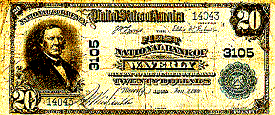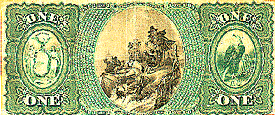 The
new system worked well. National banks bought U.S. government securities, deposited them
with the Comptroller, and received national bank notes in return. By being lent to
borrowers, the notes gradually entered circulation. On the rare occasion that a national
bank failed, the government sold the securities held on deposit and reimbursed the note
holders. No owner of a national bank note ever lost his or her money. The
new system worked well. National banks bought U.S. government securities, deposited them
with the Comptroller, and received national bank notes in return. By being lent to
borrowers, the notes gradually entered circulation. On the rare occasion that a national
bank failed, the government sold the securities held on deposit and reimbursed the note
holders. No owner of a national bank note ever lost his or her money. National bank notes were produced and distributed through an involved
process. Once the basic engraving and printing were done (at first by private printers,
later by the U.S. Bureau of Engraving and Printing), the notes were entered on the books
of the Office of the Comptroller of the Currency, then returned to the printer where the
seal of the Treasury Department was stamped on each.

Next, the notes were shipped to the bank whose name appeared on them, where they were
signed by two senior bank officers. The notes were then ready for circulation. National
bank notes were the mainstay of the nation's money supply until Federal Reserve notes
appeared in 1914.

National bank notes featured elaborate scenes and portraits drawn from American history.
The complexity of their design was intended to foil counterfeiters. Today, collectors
prize national bank notes as outstanding examples of the engraver's art.
More of the Changing World of Banking:
 Introduction Introduction 1790 to 1832 1790 to 1832  1832 to 1864 1832 to 1864
 1865 to 1914 1865 to 1914 1929 to 1970 1929 to 1970  1970 to Today 1970 to Today
|





